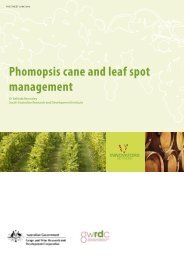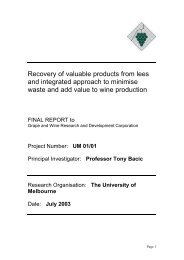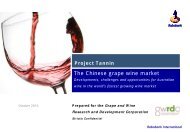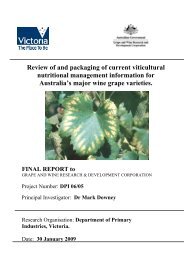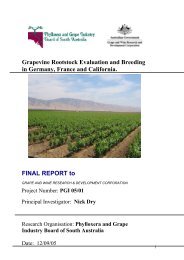Identification of the major drivers of 'phenolic' taste in ... - GWRDC
Identification of the major drivers of 'phenolic' taste in ... - GWRDC
Identification of the major drivers of 'phenolic' taste in ... - GWRDC
You also want an ePaper? Increase the reach of your titles
YUMPU automatically turns print PDFs into web optimized ePapers that Google loves.
AWRI: <strong>Identification</strong> Of The Major Drivers Of ‘Phenolic’ Taste In White W<strong>in</strong>es<br />
were <strong>the</strong> result <strong>of</strong> pH ra<strong>the</strong>r than phenolic level. The observed relationship between viscosity and pH has<br />
not been reported before. Anecdotally, <strong>the</strong> mouth-feel <strong>of</strong> high pH w<strong>in</strong>es has sometimes been described as<br />
‘soapy’, which may relate to viscosity. However, while this explanation is speculative, <strong>the</strong> very strong<br />
relationship between pH and viscosity suggests that <strong>the</strong> effect <strong>of</strong> pH on viscosity may be a direct one.<br />
In order to assess <strong>the</strong> role <strong>of</strong> o<strong>the</strong>r factors o<strong>the</strong>r than pH on <strong>the</strong> astr<strong>in</strong>gency <strong>of</strong> <strong>the</strong>se w<strong>in</strong>es, <strong>the</strong> strong<br />
l<strong>in</strong>ear effect <strong>of</strong> pH was subtracted from <strong>the</strong> total observed effect to obta<strong>in</strong> a ‘residual’ effect attributable to<br />
o<strong>the</strong>r factors <strong>in</strong>clud<strong>in</strong>g phenolics. The same strategy was applied to <strong>the</strong> viscosity rat<strong>in</strong>gs. A significant<br />
difference <strong>in</strong> astr<strong>in</strong>gency follow<strong>in</strong>g <strong>the</strong> removal <strong>of</strong> <strong>the</strong> pH effect was observed (p=0.058), suggest<strong>in</strong>g that<br />
o<strong>the</strong>r factors <strong>in</strong>clud<strong>in</strong>g phenolic content contributed to <strong>the</strong> astr<strong>in</strong>gency <strong>of</strong> <strong>the</strong>se w<strong>in</strong>es. There was no<br />
overall effect <strong>of</strong> w<strong>in</strong>emak<strong>in</strong>g treastments on difference <strong>in</strong> pH adjusted viscosity as <strong>the</strong> observed effects<br />
were variety dependent.<br />
There were no significant differences <strong>in</strong> hotness result<strong>in</strong>g from <strong>the</strong> w<strong>in</strong>emak<strong>in</strong>g treatments (p=0.349),<br />
(Table 8-3). There was a significant difference <strong>in</strong> bitterness between samples (p=0.13), with bitterness<br />
<strong>in</strong>creas<strong>in</strong>g <strong>in</strong> <strong>the</strong> order <strong>of</strong> <strong>in</strong>creased maceration and total phenolics (Figure 8-15). While bitter after<strong>taste</strong><br />
did not differ statistically (p=0.239) it <strong>in</strong>creased <strong>in</strong> a parallel fashion to <strong>in</strong>-mouth bitterness.<br />
84<br />
Table 8-3: Significance (p values) for experimental effects 2010 w<strong>in</strong>es<br />
Astr<strong>in</strong>gency<br />
adj for pH<br />
Viscosity<br />
adj for pH<br />
Bitter Bitter AT Hotness<br />
Variety 0.787 0.589 0.497 0.492 0.542<br />
Treatment 0.058 0.392 0.013 0.239 0.349<br />
Variety*Treatment 0.550 0.055 0.833 0.455 0.841<br />
Ferment(Treatment) 0.918 0.559 0.975 0.668 0.442<br />
Bold <strong>in</strong>dicates statistical difference (p




